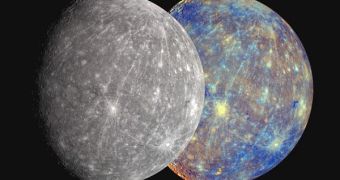The second Mercury flyby of the Messenger probe of more than 3 weeks ago, on October 6th, provided images of a zone representing 30% of the planet that hadn't been previously photographed from a spacecraft, and added to the data and knowledge scientists have on the first rock from the Sun. The first conclusions the experts came to indicated an intricate inner structure and an active volcanic history for Mercury. The photographs also showed that a previously observed dark blue material was spread in patches in this region.
The material in question is of a darker tone than the rest of the surface, and appears to have been extracted from the depths by collisions. But, since not all similarly-sized craters contain the material, specialists believe that the deposits are not consistently and evenly spread beneath the crust, ruling out the planet's “even, layer-cake geology” possibility, according to Mark Robinson from Tempe's Arizona State University. Speculations on the composition of the material have it that it may contain iron-titanium mineral ilmenite, also present on the Moon, or silicate rock with particularly-distributed iron atoms.
The newly-charted zone of the western equator was found to be about 30% smoother than the previously known zones, with less height differences in its geological features. A 600-meter high “wrinkle ridge” was discovered on Mercury's surface though, which is double the size of similar Martian features, indicating the evolution of the planet's ancient cooling and shrinking process. Mercury's volcanic past was proved by the presence of large craters which, although sharing the same approximate size, show different depths.
For instance, one of them was 4 times deeper than a nearby one of the same height. This indicates that the latter was filled by an enormous quantity of lava. “That's an awful lot of volcanic material in one place for such a little planet,” notes MIT's Maria Zuber.
The next flyby, which is the third and last part of the process that will help the Messenger probe slow down and enter a regulate orbiting process on March 18th, 2011, will take place on September 29th, 2009. After the probe is in constant orbit during a year-long mission, a lot more information will be obtained on the first planet.

 14 DAY TRIAL //
14 DAY TRIAL //